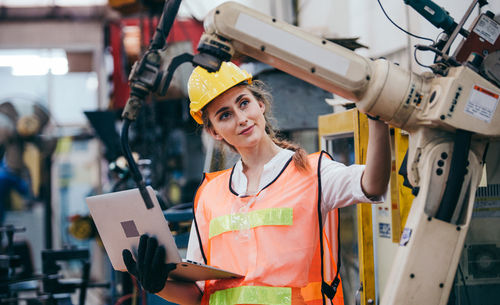The continuous development of robotics means that industrial robots are used in more and more applications. For this reason, robot safety is also constantly changing and improving.
Table of contents:
- Industrial robots – applications
- Safety in robotics and legislation
- Robot safety – protective measures
- Robotics safety standards – summary
Industrial robots – applications
The robotics industry is constantly evolving, introducing industrial robots to the next stages of the widely understood production process. The primary task of any robot involved in the production process is to facilitate the work of humans and replace them wherever necessary. For example, we are talking about monotonous tasks requiring precision and repeatability.
Another advantage of robots is that they can work in harmful environments where humans are not allowed to be or can only do so for a certain time for occupational safety reasons. An excellent example of this is industrial robots working in casting rooms with temperatures of several hundred degrees Celsius.
Regardless of whether we are dealing with a manual, automated or robotic workstation, a certain machine safety standard must be maintained. This includes, first and foremost, the appropriate protection of any moving parts that could pose a potential risk to operators and people in the vicinity of the robotised workstation.
Regarding safety robotics, we can distinguish between robots working in a designated area, where they pose no danger to humans, and collaborative robots. In the latter case, the operators are working with machinery receiving support to perform the most challenging, most monotonous or most precise operations.
While ensuring occupational safety is relatively easy for machines working in dedicated areas, for cooperating robots, the matter becomes much more complicated, with the designer having to consider, for example, how to ensure the rotating equipment safety of a robot that is cooperating with a human.
Safety in robotics and legislation
The way in which the design of robotic workstations should be approached and how to ensure robot safety is clearly set out in a number of standards. These describe how to perform a risk analysis for these types of workstations and by what means these risks should be minimised. The following standards are included in the EU Machinery Directive 2006/42/EC:
- PN-EN ISO 12100:2012 “Safety of machinery. General principles for design. Risk assessment and risk reduction”;
- PN-EN ISO 10218-1:2011E “Robots for industrial environments. Safety requirements. Part 1: Robots”;
- PN-EN ISO 10218-2:2011E “Robots for industrial environments. Safety requirements. Part 2: Robot systems and system integration”;
- PN-EN 62061:2008 “Safety of machinery. Functional safety of safety-related electrical, electronic and programmable electronic control systems”;
- PN-EN 13849-1:2008 “Safety of machinery. Safety-related parts of control systems”.
A person starting to design a robotic workstation should make sure that they have the latest and most up-to-date editions of these standards. Only in this way can safety robotics be maintained. It is important to be aware that the hazards generated by a robotic workstation vary depending on what type of robot is used, how it is installed, programmed, etc.
Robot safety – protective measures
What are 10 safety rules for designing robotic workstations? It’s hard to say whether they can be reduced to 10, but here are the most important ones. As we mentioned earlier, if the operators are not working with machinery, the robot is usually placed in a special enclosed area called a cell.
However, complete separation of the robot is not always possible. This may be the case when a conveyor picking up finished components comes out of the cell. Through such a “breach” in the fence, a person could get inside the cell or insert one of their limbs. Then, in accordance with the requirements of PN-EN ISO 12100:2012, it is necessary to use elements that detect the presence of a human being in the danger zone and immediately stop the machine. These may include various types of light curtains.
It is also common to use various elements to maintain safety standards by detecting the presence of a human inside the robot cell. These can include pressure-sensitive floor mats and various sensors and scanners that detect movement in areas where there should be none.
Although access to the inside of the cell must be locked during operation due to safety standards, the cell must not be “sealed” with panels. Each cell must have an access door that is used, for example, for servicing the machine. This type of door is usually secured with special electromagnetic locks.
Access to the inside of the cell can also be secured by security keys, without which no unauthorised person without proper training can enter the robot’s working area. Sometimes, a special sequence of button presses is also used to unlock access to the cell. Without knowing this sequence, it is impossible to enter the cell.
Safety features also include emergency stop buttons, which should be located inside the robot cell. These protect the person inside the cell from an uncontrolled start-up of the robot by another person. Additional components that help to maintain the safety standards of the robot workstation are all kinds of audible and visual alarms produced by signal lights and columns.
Robotics safety standards – summary
In summary, given the speeds at which industrial robots operate and how heavy their tooling is sometimes, it becomes extremely important that robotic workstations are adequately secured in such a way that the robots do not pose a risk to their operators or workers in the same area.
The safety standards that must be maintained in the design of robotic workstations are described in detail in the EU Machinery Directive 2006/42/EC and the standards contained therein.
If you are interested in purchasing or upgrading a robotic workstation, we invite you to contact Unilogo. On our website, you will find a contact form through which you can get in touch with our specialists, who will surely answer all your questions and help you choose the best solution.


